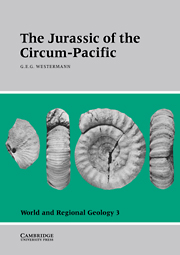Book contents
- Frontmatter
- Contents
- List of contributors
- Preface
- Acknowledgments
- Introduction
- Part I Time scales
- Part II Circum-Pacific base map
- Part III Regional geology and stratigraphy
- Part IV Biochronology
- Part V Biogeography
- 18 Macroflora of eastern Asia and other circum-Pacific areas
- 19 Ostracods and foraminifers of Western Interior North America
- 20 Ostracods of China
- 21 Corals of the circum-Pacific region
- 22 Brachiopods of the circum-Pacific region
- 23 Belemnites of the circum-Pacific region
- 24 Ammonites of the circum-Pacific region
- 25 Fishes of the circum-Pacific region
- 26 Marine reptiles of the circum-Pacific region
- Part VI Climatology and oceanography
- Appendix: Biochronology and atlas with index and guide fossils
- General Index
- Index of Guide- and Indexfossils
26 - Marine reptiles of the circum-Pacific region
Published online by Cambridge University Press: 04 August 2010
- Frontmatter
- Contents
- List of contributors
- Preface
- Acknowledgments
- Introduction
- Part I Time scales
- Part II Circum-Pacific base map
- Part III Regional geology and stratigraphy
- Part IV Biochronology
- Part V Biogeography
- 18 Macroflora of eastern Asia and other circum-Pacific areas
- 19 Ostracods and foraminifers of Western Interior North America
- 20 Ostracods of China
- 21 Corals of the circum-Pacific region
- 22 Brachiopods of the circum-Pacific region
- 23 Belemnites of the circum-Pacific region
- 24 Ammonites of the circum-Pacific region
- 25 Fishes of the circum-Pacific region
- 26 Marine reptiles of the circum-Pacific region
- Part VI Climatology and oceanography
- Appendix: Biochronology and atlas with index and guide fossils
- General Index
- Index of Guide- and Indexfossils
Summary
The record
Remains of Jurassic marine reptiles are scarce in the circum-Pacific area and have been found only in Australia, Thailand, Laos, China, Canada, the United States, Cuba, Mexico, Chile, and Argentina (Figure 26.1). The most diverse fauna comes from the Andean Basin (Aubouin et al. 1973), extending from northern Chile to west-central Argentina. It includes the earliest teleosaurids, ichthyosaurs, and plesiosaurs of the Pacific area, as well as excellently preserved Tithonian plesiosaurs, ichthyosaurs, turtles, and marine crocodiles. Our knowledge of the marine reptiles of the circum-Pacific area is limited by the poor quality of material, often consisting of isolated vertebrae and indeterminable postcranial fragments on which the new taxa are based. Thus, many of the generic, specific, and even family names are invalid (Chong Diaz and Gasparini 1976; Gasparini 1979, 1985; Gasparini and Goñi 1990). Paleobiogeographic interpretations must therefore be treated with caution, particularly because the ages sometimes are unknown.
Representative specimens are illustrated in Plate 133.
Ichthyosauria. The oldest finds are from the Hettangian of northern Chile (Chong Díaz 1977; Gasparini 1979, 1985). Other, indeterminable fragments have been found also in the Callovian, Oxfordian, and Kimmeridgian (Chong Díaz and Gasparini 1976). Two Bajocian skulls from central Chile (Jensen and Vicente 1976) have tentatively been referred to Ichthyosaurus sp.
Isolated vertebrae from the Early Jurassic of the Neuquén Basin, Argentina, were the basis of the alleged new species Ichthyosaurus(?) sanjuanensis and Ancanamunia(?) espinacitensis (Rusconi 1948a, 1949), but both are “nomina vana” (Gasparini 1985).
- Type
- Chapter
- Information
- The Jurassic of the Circum-Pacific , pp. 361 - 364Publisher: Cambridge University PressPrint publication year: 1993
- 2
- Cited by



